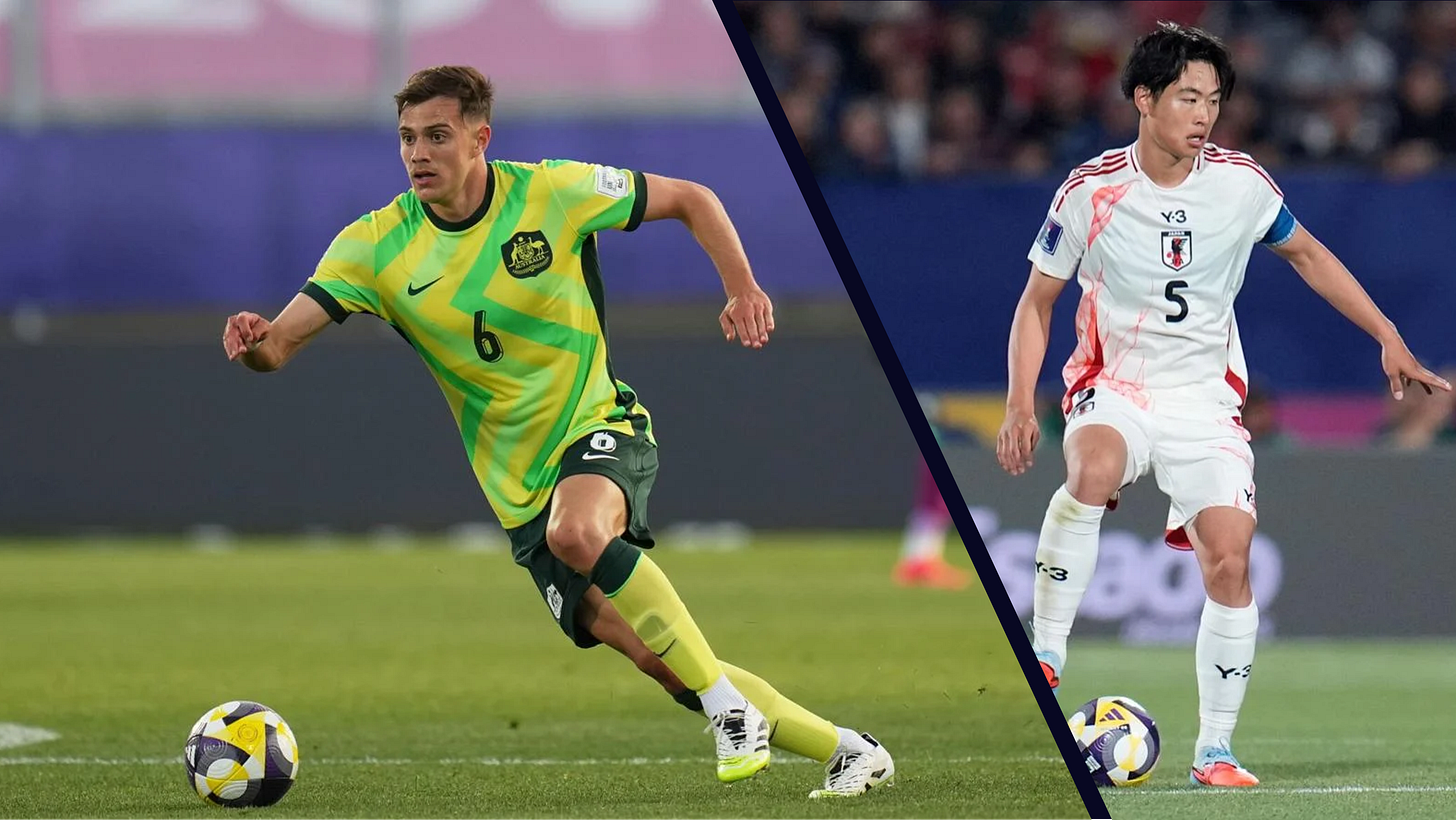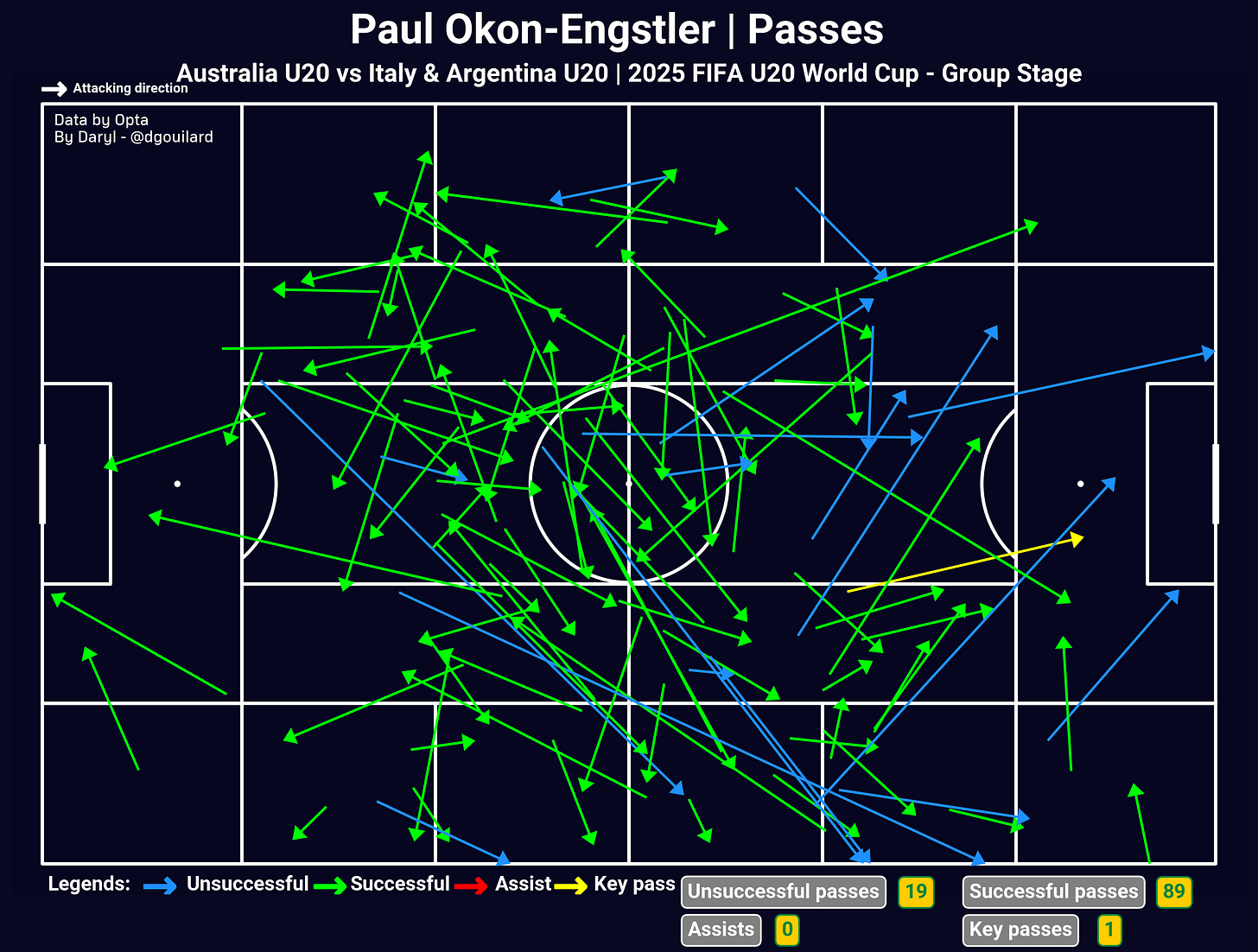Paul Okon-Engstler and Rion Ichihara are great to watch
The firsts of few scout reports coming from the U20 World Cup!
At the time of writing, matchday 2 of the U20 World Cup has come to an end with a few teams already secured their ticket to the next round while the rest are still battle for the remaining spots. Along with those results, a host of promising youngsters from across the globe also had the opportunity to bring their talent to the world stage and showcased it in front of many fans in Chile and many more watching through FIFA+.
With this first edition of my U20 World Cup scout reports, I have decided to highlight two players from two AFC representatives that I have really enjoyed watching so far. It is definitely easy to pick two players that I already have good knowledge and expectation of thanks to the U20 Asian Cup, and I will pick players from other teams that I am keeping track of for later editions, but I want to start off with two easy scout reports to gain a bit of momentum.
With that in mind, let me introduce the first player on my shortlist…
Paul Okon-Engstler
Born 2005
Central/defensive midfielder
Australia U20/Sydney FC
Australia lost their first two matches of the tournament in very different fashion as they failed to find a breakthrough against a classic, well-structured Italian defence in their opening match, and got punished heavily for their individual errors as Argentina put four past the keeper on the second matchday. Even though their chance of advancing through to the next round has taken a big hit after those two losses, that does not mean the team do not have some positives to take away. One of those positives is Paul Okon-Engstler’s performance against Italy and Argentina.
I keep finding myself using the words ‘mature’ and ‘unique’ to describe his playing style because it is rare to see an Australian midfielder who looks very calm and composed on the ball while also controls the midfield well (probably since Aaron Mooy), let alone someone who is 20 years old or younger. A few young Aussie midfielders who are currently in the Socceroos pool like Max Balard or Patrick Yazbek are more known to be hard-workers and are not shy away from making challenges, which is the midfield type that you would normally expect from an Aussie midfielder like many examples in the past (Mile Jedinak, Massimo Luongo or Jackson Irvine). In contrast, players like Riley McGree or Connor Metcalfe tend to operate inside the final third instead of deeper areas on the pitch. The closest comparison that I can think of from the current Socceroos pool is Ryan Teague and he is currently having a bit of ups and downs at Mechelen.
When I watched Okon-Engstler at this tournament and at the U20 Asian Cup, there was a sense of assurance that if he received the ball from any of his teammates, he was likely to find a way out of the opposing player’s pressure, either by carrying the ball himself or passing the ball to a teammate who could continue progressing the team’s build-up. On many occasions when he was pressed by an Italian player, he used his strength to hold off the opposition and turned to the opposite side of the pitch or faced forward to find a teammate to pass the ball to.
His passmap here probably doesn’t do him a lot of justice because it looks like he made a lot of sideways and backwards passes, but those passes were very crucial to the Young Socceroos’ build-up, especially the sideways passes, since they were used to escape the pressure from the opposition and allowed the ball to find someone who was either unmarked or was facing forward. I am stressing this trait from Okon-Engstler as an important one because, unlike the SL Benfica academy graduate, many of Australia U20 players got dispossessed fairly easy by the opposing players on numerous occasions. This has resulted in plenty of dangerous turnovers inside of the team’s own half, sometimes even inside their own defensive third, and both Italy and Argentina have punished them a few times with a dangerous shot or a goal.
Okon-Engstler’s reading of the game and situation is also good and he has been using that to the full extent. On the ball, it has helped him make line-breaking passes to find teammates in more advanced positions and got the ball out of the build-up phase and into the attacking phase. According to FIFA’s data, 11 out of 23 line-breaking attempts from the Young Socceroos’ #6 was through Italy’s defensive block, which highlights Okon-Engstler’s tendency to find teammates who sat in between the opposition’s defensive lines.
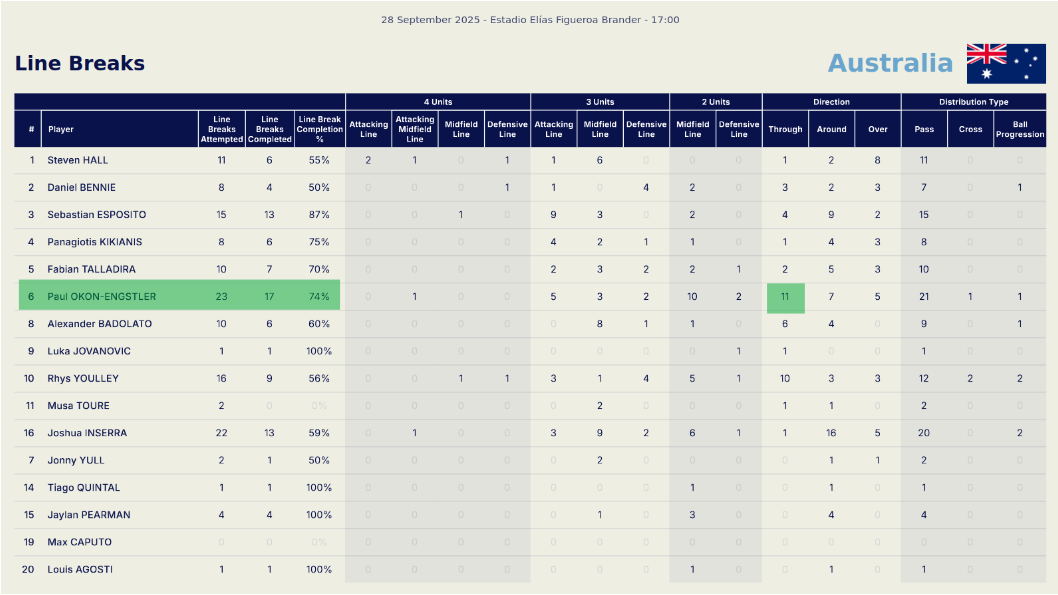
Off-the-ball, his reading of the situation allowed him to position himself in advantageous positions to receive the ball from his teammates and then turned to face forward afterwards. It was very common to spot Okon-Engstler sitting behind or just to the side of the opposition’s attacking line (or strikers line) offering to receive the ball. Once again, this is not a frequent sighting from most young Aussie midfielders playing at a big tournament like the U20 World Cup because there is a sense of nervousness to do so against technically-and/or-physically-superior players, or most players would opt for a back or sideway pass to a centre-back or a full-back who would then play a long ball forward. That is one of the few reasons why I think his playing style is mature and unique because it is just not a common trait found amongst Aussie midfielders unless they go to Europe and get coached to do so on a frequent basis. Once again, FIFA’s data highlighted this trait from Okon-Engstler well as he led the team for number of offers made and received against Italy U20.
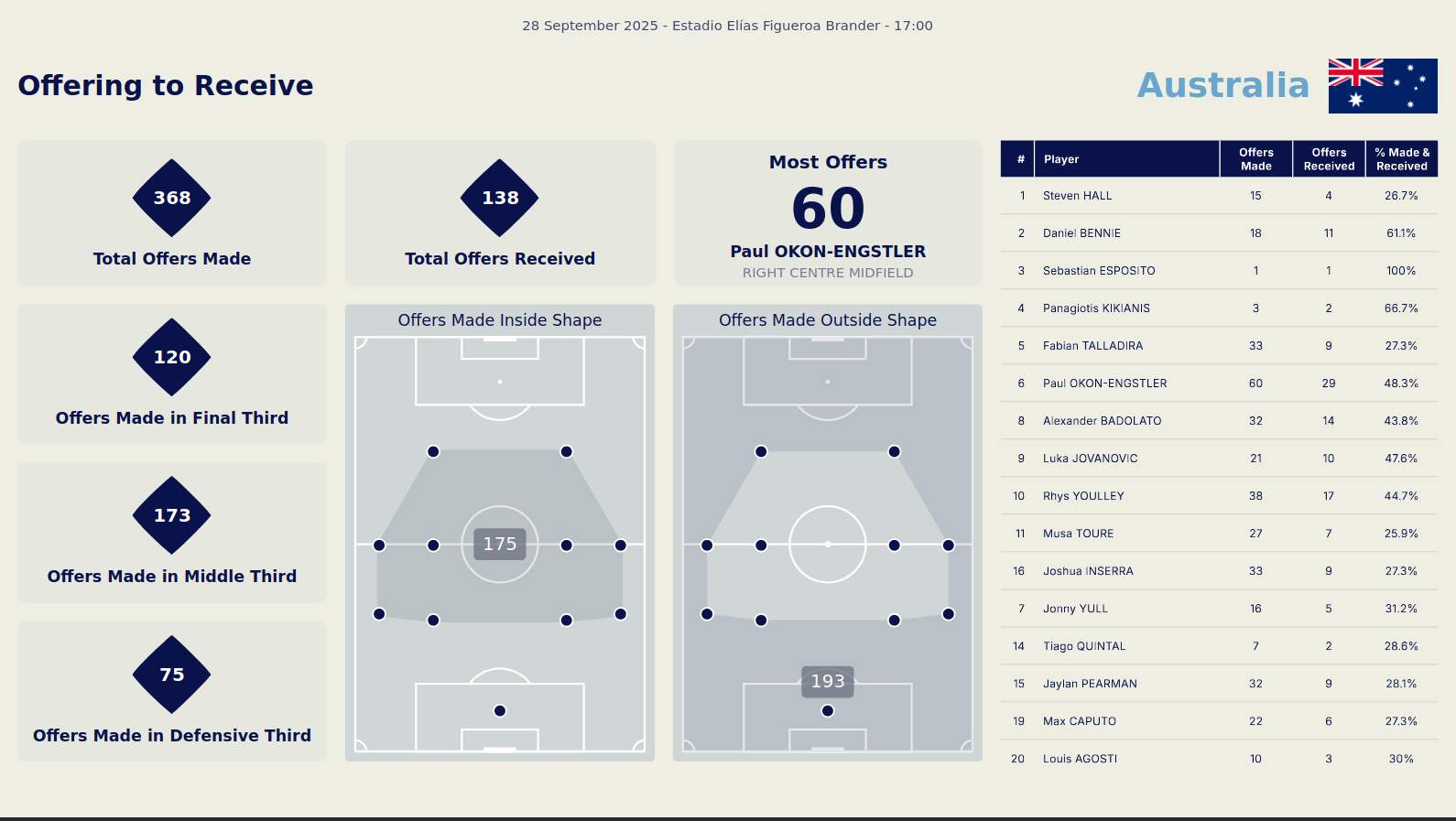
A good example of Okon-Engstler’s trait of offering to receive the ball in advantageous spaces is this short possession sequence against Italy U20. After the ball was passed to (#8) Alex Badolato, Okon-Engstler immediately turned to face forward while also separated himself from the attacking line to receive the next pass completely unmarked. As he controlled the ball, he looked towards the opposite side and noticed the free space where right-back (#16) Josh Inserra and striker (#9) Luka Jovanovic were ready to receive the ball, which he did find the Young Socceroos’ #9 with a short pass.
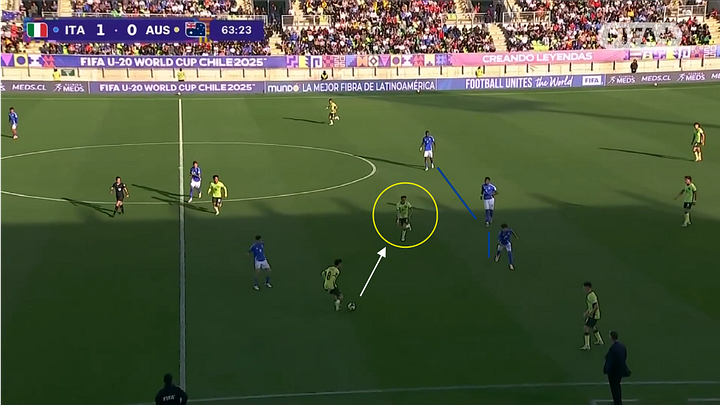
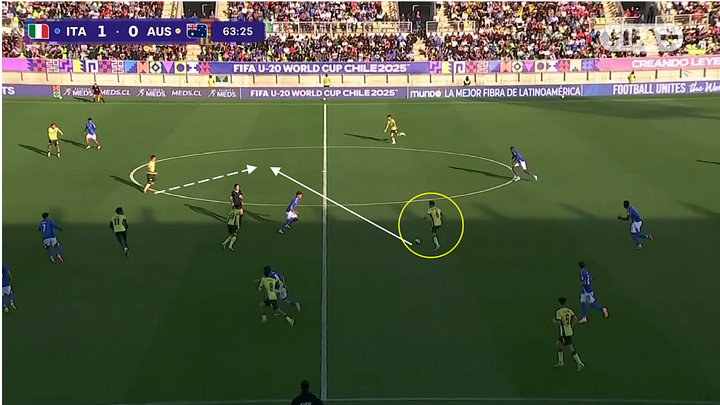
If he chose to take on the opposition players by himself, his ability to control the ball in tight spaces and his own technical ability tended to come in very handy. There were a few occasions against Italy where Okon-Engstler had the ball and decided to dribble over a couple of players, and you could see him skipped pass a challenge very easily by keeping the ball close to him and tricking the opposing player into making a challenge.
If it was a carry over a short distance to bring the ball forward, he had the tendency to do a stop-start carry (carried the ball then stopped) to bait the opposition to jump forward and close him down, which then opened up the space in behind for one of his teammates to move into and for himself to target with a line-breaking pass. Even though he was quite good at dribbling the ball, it was very rare to see Okon-Engstler take on any more than 2 or 3 players or dribble over a long distance. He only dribbled or carried the ball himself to put himself in a good position to make a pass forward instead of over-relying on his own technical ability.
Defensively, Okon-Engstler also came across as a smart midfielder instead of the usual aggressive midfielder that many Australian midfielders are. It means he did not try to regain the ball by throwing himself into tackles or try to outmuscle the opposition player on a frequent basis, even though he has the physicality to and has done so occasionally. More often, he could be found tracking an opposition player who was making an off-ball run into the box or screened a nearby passing option to look for an opportunity to intercept passes coming his way. He also showed a high level of determination on a few occasions against Italy and Argentina and used his pace to chase down a ball carrier if there were no teammates who were either close to or were willing to challenge the ball carrier.
While his defending style can be good when he is paired alongside a more defensive-minded midfielder or he has more coverage from the attacking line, so far it has left the Young Socceroos in vulnerable situations on a few occasions. In a midfield pairing with (#10) Rhys Youlley where he was playing deeper, Okon-Engstler was also expected to provide defensive support for the defenders behind him, which did not suit his slightly passive defending style. Both Italy and Argentina have managed to play through Australia’s defensive block a few times because the midfielders were not aggressive enough and put the defensive line in a vulnerable position, and, as I have pointed out in my preview that both centre-backs (#3) Sebastian Esposito and (#4) Panagiotis Kikianis were slightly prone to making individual errors, that meant that Australia’s opposition were able to attack the space in behind their defensive line very easily.
Nonetheless, Okon-Engstler is still a very special talent that can only get better now that he has headed back to Sydney FC for his first full season as a first-team player. Taking the drop down from playing with Benfica’s B team in the Portuguese pyramid is somewhat of a risk, but the A-League has been a platform to stardom for so many domestic youngsters in the past few seasons, it might as well be worth a shot. I would not be surprised if he somehow becomes one of Sydney’s best players come the end of the season, and if he continues to develop his playing style against more experienced players, he could potentially head back to Europe very, very soon.
Rion Ichihara
Born 2005
Centre-back
Japan U20/RB Omiya Ardija
I think you will be hearing the name Rion Ichihara a lot more after this year’s U20 World Cup as he keeps going from strength to strength. Ryo Nakagawara has done a very early report on Ichihara that I highly recommend checking out if you are interested in how he plays in the J2 League, and since he is already on this year’s SCOUTED50 list, there will be a lot more coverage about Ichihara coming from the Scouted Football team, with whom I will leave you beyond this post. For now, I am here to review his performance in Japan’s first two group stage matches because he has been a joy to watch while also doing a bit of comparison with his performance at the U20 Asian Cup earlier this year to see how much he has developed.
Against both Egypt and Chile, the RB Omiya Ardija youngster proved to be a very important cog in Japan’s build-up as he demonstrated the traits of a modern ball-playing centre-back. Ichihara looked very calm when he had the ball, slowing the play when the opposition sat back into their mid-block to allow his teammates to move around and create spaces, but could also see the way out when being pressed by the opposing players either via a line-breaking pass or by carrying the ball forward himself.
Going up against Egypt’s 4-4-2 mid-block, Ichihara’s long passes helped the team progress into the final third on multiple occasions. The target of those passes were usually either left-back (#3) Keita Kosugi or left winger (#13) Hisatsugu Ishii as either usually found spaces around or in behind Egypt’s right-back to receive the long pass without being pressured. Along with midfielder (#10) Yuto Ozeki, they were the two key playmakers for Japan from deep and were important in progressing Japan’s attacks into the final third.
He was also capable of making passes with both feet, although it was more often seeing him making both short and long passes on his right. Starting as the right-sided centre-back in a two-man pairing and playing on his preferred side, that allowed him to make switch-play passes to find Kosugi and Ichii on the opposite side. It was one of the preferred build-up strategies by Japan as they looked to move the opposition towards the right-hand side, effectively creating space on the left for either Kosugi or Ichii to position themselves in and receive the long pass from Ichihara, allowing them to run at Egypt’s defence and make crosses into the box for Japan’s oncoming attackers or midfielders.
In defence, Ichihara formed a very strong centre-back partnership with (#4) Kazunari Kita and proved to be a dominating presence for Japan. With Funakoshi opted to play with a high defensive line, Ichihara’s pace was suited for his style as Japan’s captain usually looked to open his body towards the oncoming attackers to track any who were looking to run in behind, and then either used his pace to chase him down or stayed with the rest of the line to catch players offside. Ichihara also used his height well to win long passes and crosses that came his way from set piece situations by positioning at the far post and clearing crosses coming his way, which was important given that, against Egypt and Chile, Japan conceded a total of 12 corners in both matches.
What differed Ichihara from Kita is his slightly reactive defensive style that does not rely on getting stuck into challenges and making unnecessary tackles. Ichihara preferred to be a bit more patience and looked for the right opportunity to regain possession for his team while also waiting for his teammates to regroup and provide support. According to FIFA’s data, Japan’s #5 only regained possession 6 times in total over the first two matches (3 against Egypt and 3 against Chile). This could also be a result of Japan’s defensive style that looked to regain possession in wide areas, thus allowing the centre-backs to be more reactive in defending.
However, Ichihara compensated for his passive defensive style by being an extremely vocal voice at the back, which was also the reason that earned him the captain armband. It was possible to spot Ichihara instructing his teammates on where to position themselves during set piece situations or encouraging the team after a stop in play on many occasions. Combining that with his calm and composed playing style, it was understandable why he has proven to be so influential in Japan’s six-point tally and 0 goals conceded so far in group A.
It is also hard not to talk about Ichihara without mentioning the two penalties that he scored. As he stepped up on both occasions, he was not fazed by the distractions from the opposition while also kept his head down and concentrated on his task. The way he struck the penalties also showed the level of confidence that he had. His penalty against Egypt was a powerful one to the left-hand side of the goal, while the one against Chile was a cold penalty as he chipped the ball straight down the middle, with both times sending the keeper the wrong way.
After Kōta Takai left a huge impression at the 2023 edition of the U20 World Cup, it is Rion Ichihara’s turn to step up and be both a leader and a key player in Japan’s defence in this year’s tournament. His performance at the U20 Asian Cup earlier this year was already impressive enough, but he continued to surprise me with what he can do on the global stage. With him now under the Red Bull umbrella, he has every chance to be Omiya’s first export to either Salzburg or Leipzig in the near future, and they might need to get Ichihara on the move quick because he must be on the watchlist of a few European clubs by now.
As the tournament heads towards the last matchday of the group stage, more teams and players will be more familiar with playing in Chile, which can only be a good thing as it will allow them to be more comfortable on the pitch and show their true ability. While I have not been able to watch every match of the U20 World Cup so far, I have tried to watch a few matches here and there and have had a few names on my own shortlist, including Rion Ichihara and Paul Okon-Engstler, whom I have introduced to you above.
I will return with at least a couple more reports about players that have caught my eyes very soon. But, for now, if you want a taste of the players who are not currently playing in this tournament, head over to Scouted Football and dive into their annual SCOUTED50 list. With the new Football Manager also coming very soon, you will definitely want to note down a few names on that list to sign right away in your first save!


